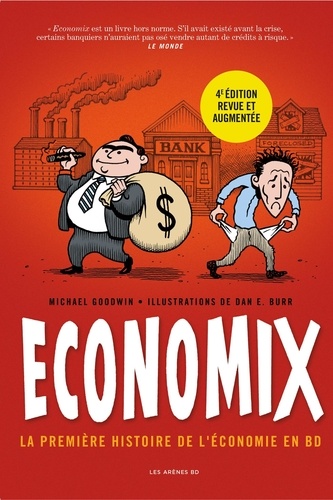
While the basic information is technically accurate, it has about the same depth of analysis and understanding as that you might get watching cable news, and at times can be equally contradictory. The last two books I read were parts one and two of The Cartoon Introduction to Economics by Yoram Bauman and illustrated by Grady Klein (published by Hill and Wang, 2012). This is a two-volume economic primer that probably is not much different than what you might learn in high school. Thompson captures the development Albert and his colleagues and friends with a surprising subtlety given the black and white medium and that in most cases he is trying to accurately represent real people. Of all the works I have looked through for this article, Parecomic has the strongest art. Like all other comics about economics, it also surely opens up discussion with readers who would never otherwise read anything by Michael Albert. But it is valuable in that it goes beyond economics to lay out a vision for a more intricate view of the incentives and motivations of humanity. The political impact of the book is, for now, rather small. The result was a system similar to Syndicalism in which the workers collectively own and operate the means of production and compensation is determined, not by output, but by the burdensomeness of the tasks completed and the dedication with which a worker performs their appointed duties. The book goes into to quite a bit of detail about Albert’s critique of main stream Marxism and how he adapted the class dichotomy into a more nuanced view of the class divide, a problem which he then set about solving. The story really isn’t so much about economics as it is about the journey Albert went though in creating Participatory Economics, his theoretical replacement of the existing order. More: Available for purchase in the Ad Astra Shop Parecomic is the story of how economist Michael Albert started out in economics and activism and ultimately merged the two by forming an innovative new system of organization that rejected the myopic view of mainstream Marxism and what is known as the “Economic Left”. The next book in our trip down Economy Lane is Parecomic: the Story of Michael Albert and Participatory Economics Author: Sean Michael Wilson With regard to politics it will either solidify your case against the continued concentration of power driven by unfettered market slavery or at least make you question your belief in laissez-faire capitalism. Regardless of your politics or level of understanding, this book will leave you knowing more about economics.

Goodwin’s history is complete and in depth while Barr’s artwork presents a blend of historical personae and visual metaphor (corporations are presented throughout as giant anthropomorphic factories). It’s a clear, factually accurate critique of how the development of economics as a science has left the real world out of its equations and how that lack of depth has brought us to a critically unstable tipping point (enter perennial economic depressions, repressions, slow-downs, melt-downs… and whatever else they’re going to call it next year).

He then proceeds to dissect, in detail, the revolt of the rich and powerful and the means by which they have solidified their hold on our economy and by extension, the future.Įconomix was the first book I stumbled across when I delved into this topic, and it’s great. Goodwin is totally unafraid of the controversy he might stir up, and backs that confidence with historical insight.

It is this author’s assumption that “…today’s justifications for extreme inequalities of wealth and power are horse-pucky, just like yesterday’s, and will completely fade away.” In other words, there’s absolutely no need for a 1% to make the system work for the other 99%. As the comic starts to venture into the present day, Goodwin admits his own political ideas and history. Goodwin tells the story of the development of economics theory from its pre-Enlightenment nascent state, to the convoluted mess that we are left with today. If you came to me asking for a starting point in this arena, my surefire response would be to go out and get a copy of Economix: How Our Economy Works and Doesn’t Work In Words and Pictures.Īuthors: Michael Goodwin, David Bach, Joel Bakan There are a variety of “economic comics” to chose from out there and each one has a different approach to the field. And so daunting and courageous it is to see artists and writers undertake the so-called “dismal science” to the pages of the graphic medium. By Zachary Johnson-Dunlop | Economics is seen by most of us as one of the most boring academic disciplines: it’s all the computation of a Math degree, with the fevered opinion of a Poli-Sci degree, and most of the public understands it about half as well as they understand either of those.


 0 kommentar(er)
0 kommentar(er)
